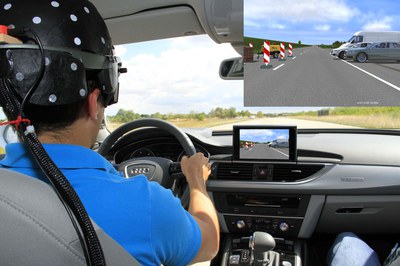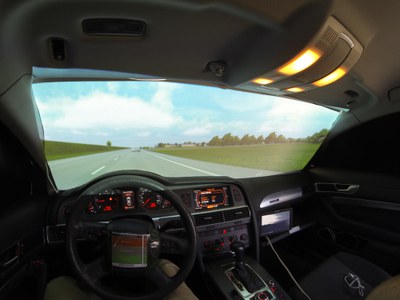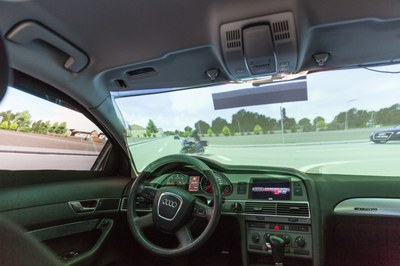Driving Simulation
Driving simulators that generate a realistic visual representation of the surrounding traffic environment, with realistic vehicle movements (linear and lateral acceleration) and appropriate acoustics are extremely expensive to build and maintain.
The Vehicle in the Loop (VIL) system is an alternative that combines the virtual imagery of a simulator with the real driving experience in a vehicle. While driving a real vehicle on a test site, the driver sees a virtual world.
By tracking the position and orientation of the test vehicle and the driver’s head, the system is able to display the corresponding section of virtual reality (VR).
There are currently three different VIL system designs
VR content is displayed via a head-mounted display (HMD). The image corresponds to the driver’s perspective and the view through the windshield onto the real track the vehicle is driving on:

The virtual world is projected onto the covered windshield with a wide-angle projector:

Additional flat screens complete the view of a simulated world through the left and right side windows:

All three concepts do not allow the driver to see the real environment of the vehicle. Therefore, an open space or test track is required where the VIL system can safely be driven. At UniBw M, the VIL system is used on the University’s test site. The real roads as they exist on the test site were digitally recreated to form a virtual environment.
By combining a simulator with a vehicle that really moves, VIL offers all the advantages that standard driving simulators provide. Critical traffic situations can be reproduced as often as needed without endangering anyone. In addition, however, the real movement of the vehicle eliminates the biggest drawback of conventional simulators, i.e. that the simulated vehicle dynamics never truly feel real.
Virtual sensor models further provide an interface that makes it possible to record the driving situation in the virtual world. By connecting the sensor models to the vehicle’s real control units, the vehicle is integrated into the control loop. This facilitates the cost-efficient development and reliable evaluation of new driver assistance systems before testing them in real scenarios.
Development of the Vehicle in the Loop System
The VIL system was originally developed by Th. Bock as part of his dissertation with Audi before it was taken over by Carmeq GmbH. As part of a cooperation project between the Institute of Human Engineering and Carmeq GmbH, the VIL system was established and further developed at UniBw M.
Literature
Berg, Guy: "Das Vehicle in the Loop – Ein Werkzeug für die Entwicklung und Evaluation von Fahrerassistenzsystemen". Dissertation Universität der Bundeswehr München, 2014.
Berg, Guy; Färber, Berthold: "Vehicle in the Loop". In: Winner, Hermann; Hakuli, Stephan; Lotz, Felix; Singer, Christina (Hrsg.): "Handbuch Fahrerassistenzsysteme – Grundlagen, Komponenten und Systeme für aktive Sicherheit und Komfort". ATZ-MTZ-Fachbuch. Springer Vieweg Wiesbaden, 20153, S .155-163.
Popp, Michael M.; Färber, Berthold: „Simulation of the Acoustics of Truck-Driving“. In: Brookhuis, Karel; de Waard, Dick; Weikert, Clemens (Hrsg.), „Simulators and Traffic Psychology, Proceedings of the Human Factors and Ergonomic Society Annual Meeting 1996, Groningen, the Netherlands”, Centre for Environmental and Traffic Psychology, University of Groningen. 1997. S. 83-91.